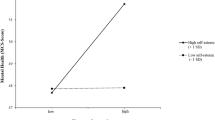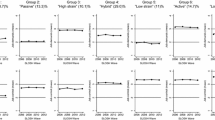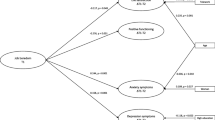Abstract
Objectives
Job strain has been implicated in a range of employee health outcomes including psychiatric health. Much of the literature is drawn from studies that utilise cross-sectional designs, whilst the long-term follow-up of participants is limited. We examine the short and long-term risks of job strain for depression and wellbeing over a 12-year period. In particular, we utilise measures of wellbeing to emphasise the importance of discriminating between indices of subjective and psychological wellbeing that complement measures of mental health.
Methods
Participants (n = 2530) were aged between 40 and 44 years at baseline and were drawn from the Personality and Total Health (PATH) Through Life Project. Participants were observed once every 4 years for 12 years.
Results
A high strain job was associated with an increased risk of reporting sub-syndromal [RRR = 1.66 (95 % CI 1.23; 2.25), p < 0.001], minor [RRR = 1.92 (95 % CI 1.19; 3.10), p < 0.001] and major depression [RRR = 2.19 (95 % CI 1.30; 3.67), p < 0.001], but strain was not a long-term risk for depression 4 years later. In contrast, strain was a risk for both cross-sectional and longitudinal wellbeing outcomes. Moving into a high strain job was a risk for developing depression [RRR = 1.81 (95 % CI 1.26; 2.59), p < 0.001], but the cumulative exposure to a high strain job was not associated with poorer outcomes in adjusted models.
Conclusions
Overall, our results emphasise the importance of current job strain, and the risk of moving into a high strain job, on adverse mental health and wellbeing outcomes. Effects were not consistent between indices of mental health, subjective or psychological wellbeing, supporting the need to dedifferentiate between wellbeing and mental health.
Similar content being viewed by others
References
Theorell T, Karasek RA (1996) Current issues relating to psychosocial job strain and cardiovascular disease research. J Occup Health Psychol 1(1):9–26
Brunner EJ, Chandola T, Marmot MG (2007) Prospective effect of job strain on general and central obesity in the Whitehall II study. Am J Epidemiol 165(7):828–837
Nyberg ST, Fransson EI, Heikkila K, Alfredsson L, Casini A, Clays E et al (2013) Job strain and cardiovascular disease risk factors: meta-analysis of individual-participant data from 47,000 men and women. PLoS ONE 8(6). doi:10.1371/journal.pone.0067323
Netterstrom B (2014) Job strain and hypertension. Occup Environ Med 71(3):157–158
Babu GR, Jotheeswaran AT, Mahapatra T, Mahapatra S, Kumar A Sr, Detels R et al (2014) Is hypertension associated with job strain? A meta-analysis of observational studies. Occup Environ Med 71(3):220–227
Faragher EB, Cass M, Cooper CL (2005) The relationship between job satisfaction and health: a meta-analysis. Occup Environ Med 62(2):105–112
Stansfeld SA, Clark C, Caldwell T, Rodgers B, Power C (2008) Psychosocial work characteristics and anxiety and depressive disorders in midlife: the effects of prior psychological distress. Occup Environ Med 65(9):634–642
John U, Riedel J, Rumpf HJ, Hapke U, Meyer C (2006) Associations of perceived work strain with nicotine dependence in a community sample. Occup Environ Med 63(3):207–211
Lallukka T, Lahelma E, Rahkonen O, Roos E, Laaksonen E, Martikainen P et al (2008) Associations of job strain and working overtime with adverse health behaviors and obesity: evidence from the Whitehall II study, Helsinki Health study, and the Japanese Civil Servants study. Soc Sci Med 66(8):1681–1698
Kouvonen A, Kivimaki M, Vaananen A, Heponiemi T, Elovainio M, Ala-Mursula L et al (2007) Job strain and adverse health behaviors: the Finnish public sector study. J Occup Environ Med 49(1):68–74
Stansfeld S, Candy B (2006) Psychosocial work environment and mental health—a meta-analytic review. Scand J Work Environ Health 32(6):443–462
Ahola K, Honkonen T, Isometsa E, Kalimo R, Nykyri E, Koskinen S et al (2006) Burnout in the general population. Results from the Finnish Health 2000 study. Soc Psychiatry Psychiatr Epidemiol 41(1):11–17
Wang MJ, Mykletun A, Moyner EI, Overland S, Henderson M, Stansfeld S et al (2014) Job strain, health and sickness absence: results from the Hordaland Health study. PLoS ONE 9(4). doi:10.1371/journal.pone.0096025
Suominen S, Vahtera J, Korkeila K, Helenius H, Kivimaki M, Koskenvuo M (2007) Job strain, life events, and sickness absence: a longitudinal cohort study in a random population sample. J Occup Environ Med 49(9):990–996
McTernan WP, Dollard MF, LaMontagne AD (2013) Depression in the workplace: an economic cost analysis of depression-related productivity loss attributable to job strain and bullying. Work Stress 27(4):321–338
Dollard MF, Winefield HR, Winefield AH, de Jonge J (2000) Psychosocial job strain and productivity in human service workers: a test of the demand-control-support model. J Occup Organ Psychol 73:501–510
Soderberg M, Harenstam A, Rosengren A, Schioler L, Olin AC, Lissner L et al (2014) Psychosocial work environment, job mobility and gender differences in turnover behaviour: a prospective study among the Swedish general population. BMC Public Health 14:605. doi:10.1186/1471-2458-14-605
Lamontagne A, Sanderson K, Cocker F (2010) Estimating the economic benefits of eliminating job strain as a risk factor for depression. VHPF (VicHealth), Carlton
Stansfeld SA, Shipley MJ, Head J, Fuhrer R (2012) Repeated job strain and the risk of depression: longitudinal analyses from the Whitehall II study. Am J Public Health 102(12):2360–2366
Wang J, Schmitz N, Dewa C, Stansfeld S (2009) Changes in perceived job strain and the risk of major depression: results from a population-based longitudinal study. Am J Epidemiol 169(9):1085–1091
Tyssen R, Hem E, Gude T, Gronvold NT, Ekeberg O, Vaglum P (2009) Lower life satisfaction in physicians compared with a general population sample: a 10-year longitudinal, nationwide study of course and predictors. Soc Psychiatry Psychiatr Epidemiol 44(1):47–54
Ryff CD (1989) Happiness is everything, or is it? Explorations on the meaning of psychological well-being. J Pers Soc Psychol 57(6):1069–1081
Huppert FA, Marks N, Clark A, Siegrist J, Stutzer A, Vittersø J et al (2009) Measuring well-being across Europe: description of the ESS well-being module and preliminary findings. Soc Indic Res 91(3):301–315
Jorm AF, Ryan SM (2014) Cross-national and historical differences in subjective well-being. Int J Epidemiol 43(2):330–340
Huppert FA, So TTC (2013) Flourishing across Europe: application of a new conceptual framework for defining well-being. Soc Indic Res 110(3):837–861
Ryan RM, Deci EL (2001) On happiness and human potentials: a review of research on hedonic and eudaimonic well-being. Annu Rev Psychol 52:141–166
Headey B, Warren D (2008) Families, incomes and jobs. In: MIoAEaS (ed) Research. Volume 3: A statistical report on waves 1 to 5 of the HILDA Survey. Commonwealth of Australia, Melbourne
Baird BM, Lucas RE, Donnellan MB (2010) Life satisfaction across the lifespan: findings from two nationally representative panel studies. Soc Indic Res 99(2):183–203
Jorm AF (2000) Does old age reduce the risk of anxiety and depression? A review of epidemiological studies across the adult life span. Psychol Med 30(1):11–22
Henderson AS, Jorm AF, Korten AE, Jacomb P, Christensen H, Rodgers B (1998) Symptoms of depression and anxiety during adult life: evidence for a decline in prevalence with age. Psychol Med 28(6):1321–1328
Anstey KJ, Christensen H, Butterworth P, Easteal S, Mackinnon A, Jacomb T et al (2012) Cohort profile: the PATH through life project. Int J Epidemiol 41(4):951–960
Connor KM, Davidson JRT (2003) Development of a new resilience scale: the Connor–Davidson Resilience Scale (CD-RISC). Depress Anxiety 18(2):76–82
Burns RA, Anstey KJ (2010) The Connor–Davidson Resilience Scale (CD-RISC): testing the invariance of a uni-dimensional resilience measure that is independent of positive and negative affect. Pers Indiv Differ 48(5):527–531
Liu DWY, Fairweather-Schmidt AK, Roberts RM, Burns R, Anstey KJ (2014) Does resilience predict suicidality? A lifespan analysis. Arch Suicide Res 18(4):453–464
Pearlin LI, Schooler C (1978) The structure of coping. J Health Soc Behav 19(1):2–21
Watson D, Clark LA, Tellegen A (1988) Development and validation of brief measures of positive and negative affect—the Panas Scales. J Pers Soc Psychol 54(6):1063–1070
Diener E, Emmons RA, Larsen RJ, Griffin S (1985) The Satisfaction with Life Scale. J Pers Assess 49(1):71–75
Pavot W, Diener E, Colvin CR, Sandvik E (1991) Further validation of the satisfaction with life scale—evidence for the cross-method convergence of well-being measures. J Pers Assess 57(1):149–161
Spitzer RL, Kroenke K, Williams JBW, Primary PHQ (1999) Validation and utility of a self-report version of PRIME-MD—the PHQ primary care study. JAMA J Am Med Assoc 282(18):1737–1744
Kroenke K, Spitzer RL (2002) The PHQ-9: a new depression diagnostic and severity measure. Psychiat Ann 32(9):509–515
Kroenke K, Spitzer RL, Williams JBW (2001) The PHQ-9—validity of a brief depression severity measure. J Gen Intern Med 16(9):606–613
Kiely KM, Butterworth P (2015) Validation of four measures of mental health against depression and generalized anxiety in a community based sample. Psychiatry Res 225(3):291–298
Bosma H, Marmot MG, Hemingway H, Nicholson AC, Brunner E, Stansfeld SA (1997) Low job control and risk of coronary heart disease in Whitehall II (prospective cohort) study. BMJ 314(7080):558–565
D’Souza RM, Strazdins L, Clements MS, Broom DH, Parslow R, Rodgers B (2005) The health effects of jobs: status, working conditions, or both? Aust N Z J Public Health 29(3):222–228
D’Souza RM, Strazdins L, Lim LL, Broom DH, Rodgers B et al (2003) Work and health in a contemporary society: demands, control, and insecurity. J Epidemiol Community Health 57(11):849–854
Lerner DJ, Levine S, Malspeis S, Dagostino RB (1994) Job strain and health-related quality-of-life in a national sample. Am J Public Health 84(10):1580–1585
Eysenck HJ, Eysenck SBG (1975) Manual of the Eysenck Personality Questionnaire. Hodder and Stoughton, London
Parslow RA, Jorm AF, Christensen H, Rodgers B, Strazdins L, D’Souza RM et al (2004) The associations between work stress and mental health: a comparison of organizationally employed and self-employed workers. Work Stress 18(3):231–244
Acknowledgments
We thank Helen Christensen, Andrew MacKinnon, Simon Easteal, Anthony Jorm, Patricia Jacomb, Karen Maxwell, Kristine Koh, and the PATH interviewers. PATH has been supported by the Australian National Health and Medical Research Council (NHMRC Grant No. 973302, 179805, 350833, 157125). This manuscript was supported by the Australian Research Council Centre of Excellence in Population Ageing Research (Project #: CE110001029); ARC Future Fellowship (FT130101444 to PB); and an NHMRC Fellowship (#1002560 to KJA). The findings and views reported in this paper are those of the author(s) and not those of the original studies or their respective funding agencies.
Author information
Authors and Affiliations
Corresponding author
Ethics declarations
Conflict of interest
The authors declare that there is no conflict of interest.
Rights and permissions
About this article
Cite this article
Burns, R.A., Butterworth, P. & Anstey, K.J. An examination of the long-term impact of job strain on mental health and wellbeing over a 12-year period. Soc Psychiatry Psychiatr Epidemiol 51, 725–733 (2016). https://doi.org/10.1007/s00127-016-1192-9
Received:
Accepted:
Published:
Issue Date:
DOI: https://doi.org/10.1007/s00127-016-1192-9




